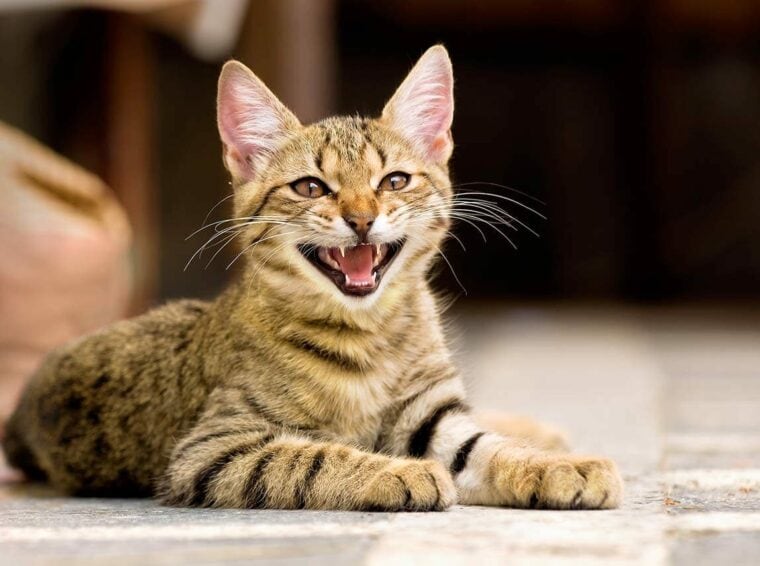
For those unfamiliar or new to owning them, cats can be the most perplexing creatures. They can appear to have an aloof—even arrogant—non-communicative air about them. For this reason, they have earned a reputation of being the royalty of pets, a title that most cat lovers will agree with.
However, once you understand a bit more about how your cat is constantly communicating with you through its various means, some of their feline enigma is dispelled. Understanding your kitty will create a more harmonious living environment for both of you. But, it may also only serve to confirm their superiority over you and all other feeble earth dwellers!
 The 25 Ways Cats Communicate
The 25 Ways Cats Communicate
1. Meowing
The most familiar way that cats communicate with us is by meowing. Did you know that meowing is a means of communication reserved strictly for humans? That’s right, meowing is a kitty’s version of human talk! They don’t meow at each other or at other animals.
They have a variety of meows, which, collectively they have developed to communicate with their specific human. If you’ve had your kitty for a while, you will know exactly what it wants by the kind of meow it’s giving you. If your kitty is a new addition, it will take some time before it has you trained to understand its every demand!

2. Mewing
Not to be confused with meowing, mewing is the soft, little sound that kittens make. Although they primarily use this to communicate with their mothers, if you adopt a young kitten, it will use this sound to communicate with you as well.
Additionally, even if mommy-cat is at home, after a few weeks, once the kittens notice you in their world, they will mew at you too.
If you adopted an older cat, this is likely a sound that you have never heard from your fur baby.
3. Chirping
This is a pleasant, almost-musical sound that cats make as a means of summoning either their kittens, their fellow felines, or you. If they chirrup to you, they’re asking you to come with them—either to feed them, or so they can show you what they’ve got for you. If it’s the latter, brace yourself, it might not be pretty! But you must receive the gift graciously!
4. Purring
Purring is one of those sure signs of a happy and relaxed kitty. Your cat is telling you to carry on doing whatever it is you’re doing and to not leave. If your kitty has been a part of your life for many years, you may have even begun to recognize and interpret different kinds of purrs.
Cats also purr, however, when they are distressed or in pain. It’s not difficult to distinguish between the two scenarios—it should be obvious if your kitty is in pain. Again, it’s your cat’s way of asking you to stay with them and care for them.
Interestingly, the sound frequency at which purring occurs has healing properties, and so could be a clever feline evolution to promote self-healing.
5. Growling
You can probably guess that if you get growled at by a cat, you’ve done/are doing something that is thoroughly disagreeable to it!
Cats will growl at humans, other cats, and other animals—and they’re categorically saying “stay away”.
Cats will occasionally also perform a quieter, throaty growl, and this is often their way of warning you of an intruder, human, or otherwise. This growl is often accompanied by them crouching flat to the ground and scuttling off to hide somewhere.
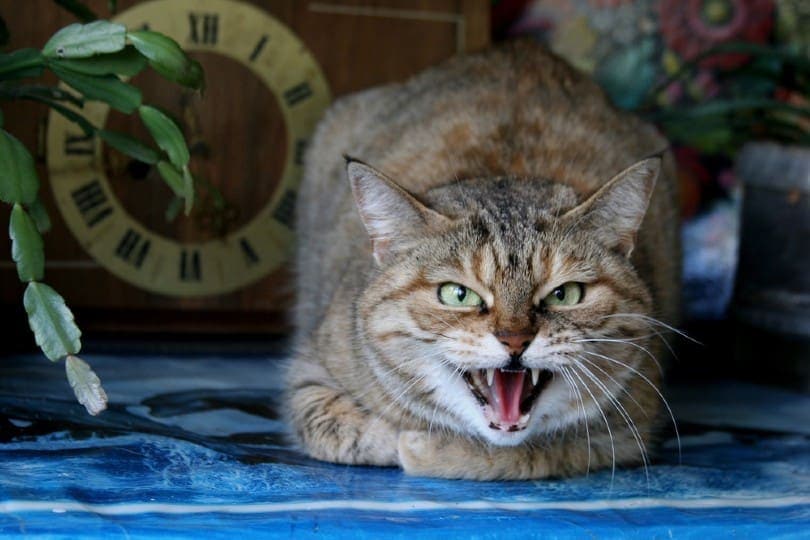
6. Hissing
Growling can quickly escalate to hissing if you, or some other annoying entity, have not heeded the initial warning. If you are hissed at, you had best make a hasty retreat and wait until your angry feline is feeling more receptive and ready to accept apologies and caresses.
7. Spitting
Spitting may accompany hissing if the kitty is particularly irate. If your cat is growling, hissing, and spitting at you, we understand if you become a bit trembly at the knees!
Cats have a peculiar air about them that makes us humans only want to please them and make them happy—a sometimes elusive goal. Angering your beloved cat to the point of it spitting at you is enough to wither even the most resolute character!
8. Yowling
Yowling is a sign of distress. You should try and ascertain what is causing the kitty distress, although the source may often be something that seems trivial, and for which nothing can be done. In the cat’s life, though, it’s a big deal! It’s still worth checking out, because now and then there will be good cause for the distress call—such as being stuck on a fence or in a tree.
Yowling is also a common sound made by unspayed and unneutered cats when they are in the company of a potential suitor and coupling is under contemplation.
9. Blinking
The all-telling kitty winks! If you notice your cat looking at you, and blinking lazily and lovingly whilst doing so, you’ve made it. This is a sure sign that your kitty loves and trusts you.
You must return your kitty’s compliment with a slow and loving blink of your own. Try variations of both eyes, or just one, and see which they like the best.

10. Exposing Belly
If your kitty flops onto their side, then rolls onto their back exposing their belly in front of you, this is a sign that you are trusted. After all, cats will only expose their sensitive bellies when they feel completely relaxed and unthreatened.
If your kitty even lets you scratch their belly, then you are in high favour! Be careful though, don’t overstep their boundaries—look out for the signal that they’ve had enough, and stop when they request. They might indicate this by rolling back onto their side, pushing your hand away, or becoming apparently disinterested in you.
11. Rubbing Against You
Your cat rubbing up against your legs is their way of telling you they love you to the moon and back. Even though the act of rubbing against you is enjoyable in itself, they have another reason for doing it. They have scent glands in their chin, cheeks, forehead, paws, and around the base of their tail. They will try and rub at least one of these parts of their body on you to impart their scent—to let other cats know that you’re their human.
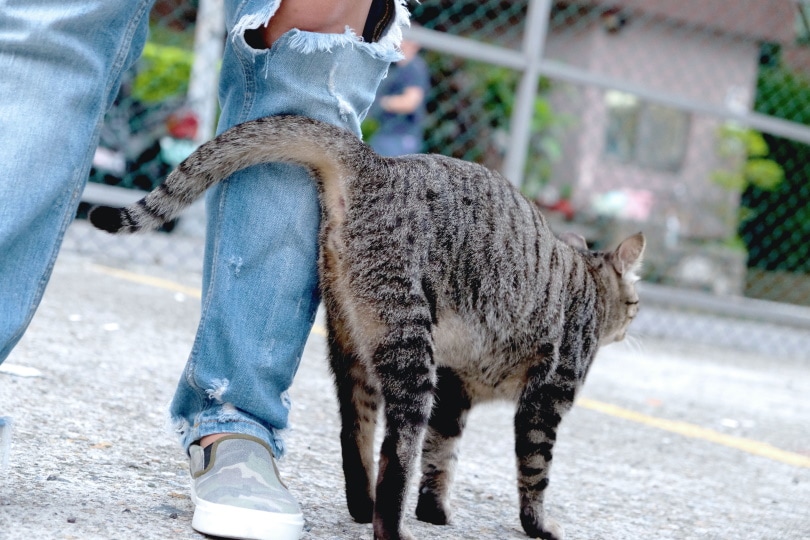
12. Head Bumping
Head bumping is another endearing way that your cat has of communicating their love for you. At the same time, they rub their forehead glands on you, marking you as belonging to them. Head bumping is a more insistent way (than leg rubbing) for your cat to let you know that they adore you. It’s almost as if they’re saying, “Hey! Notice me! I love you, human!”
It’s difficult to ignore a feline head butt, as cute and gentle as it may be.
13. Rubbing its Chin and Cheeks
This is territorial behavior. Cats use the scent glands located in their chin and cheeks to mark various objects, including their human, by leaving their signature scent all over them. This behavior, although still indicating fondness, is not quite as affectionate as head bumping or rubbing.
Cats sometimes appreciate it when you gently rub the side of your finger along their cheek as a way of saying that you are happy to be theirs.
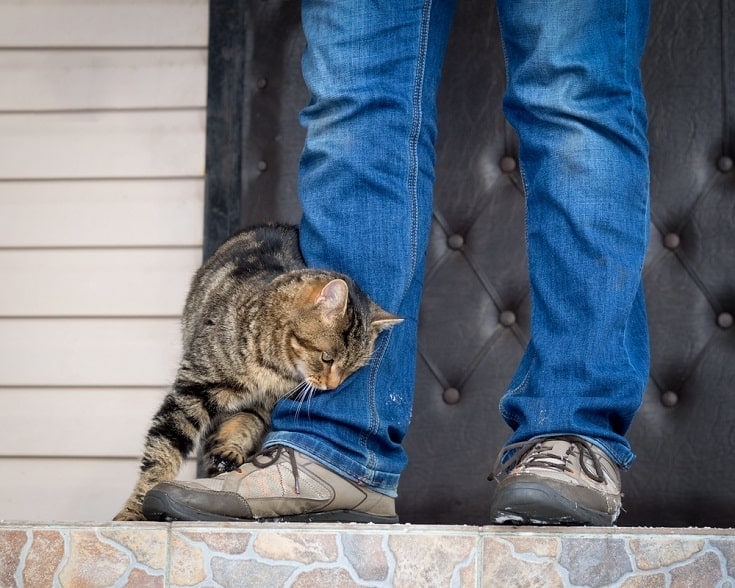
14. Scratching and Clawing
There are several reasons that a cat might scratch or claw at something:
Anger
If you, another cat, or one of the other household pets have annoyed the kitty, then a well-aimed swipe of that thorny paw might be the result.
Play
There’s a fine line between play and prey. When kitties play, they are essentially honing their hunting skills. Their claws are a formidable part of their hunting arsenal, which need regular exercising. Unfortunately, if you are a kitty’s playmate, you may be on the receiving end of the practice swipe.
Self Defense
Cats use their claws very effectively in self-defense when they are under attack from any other entity. You will be able to see a big difference between a playful scratch and a scratch received by a cat defending itself from perceived danger.
Territorial
Cats’ paws contain scent glands, so they will claw objects to leave their scent all over them. The act itself is also demonstratively territorial, giving all who care to observe a glimpse of their mighty talons.
15. Ears
A cat’s ears are full of expression and communicate their many moods very clearly.
Ears Relaxed or Pointed Forward
As you may have expected, this means that your kitty is relaxed in their environment and content with whatever is going on around them.
Ears Pointing Slightly Back
This signals a more heightened state of alertness. They are still relaxed but have become aware that something is going on that warrants their attention and possible reaction.
Ears Laid Flat Back Against the Head
If you’ve witnessed your cat with its ears like this, you know that they are a very unhappy puss cat indeed. Typically, if a kitty’s ears are laid back flat against its head, you might expect this to be accompanied by growling, hissing, or spitting, and a low-crouched attitude. This usually means that your kitty is ready to run away, defend itself, or might be the aggressor themself and about to attack.

16. Kneading
Also known as “making biscuits”, this adorable behavior begins when they are kittens. They knead the mommy-cats teats, causing her milk to let down. For them, it is associated with a state of blissful happiness, and most cats continue the behavior into adulthood.
Some cats forget to sheath their claws sufficiently when they lovingly knead their humans, and so it can be a case of “tough love” for those unfortunate humans! It’s possible to encourage clawless kneading by consistently removing their paws when they start using too much claw whilst kneading.
17. Arched Back
If the arched back is accompanied by the fur standing on end, the net effect is a kitty that looks much bigger than it is. The reason your cat might want to assume a larger-than-life stance is that they are trying to appear intimidating. Either your cat is scared of something even scarier than themself, or they are trying to daunt an adversary during a spat over territory or a potential mate.
If their fur remains perfectly laid flat, then kitty is just having a nice, big stretch and demonstrating complete relaxation.
18. Licking
Cats lick each other, and you, as a part of their grooming routine. Grooming is carried out when the kitty is relaxed—and if the grooming is extended to other cats, pets, or you, it’s a sign of their trust. They can become even more relaxed during the grooming process and often will appear to zone out in a licking stupor!
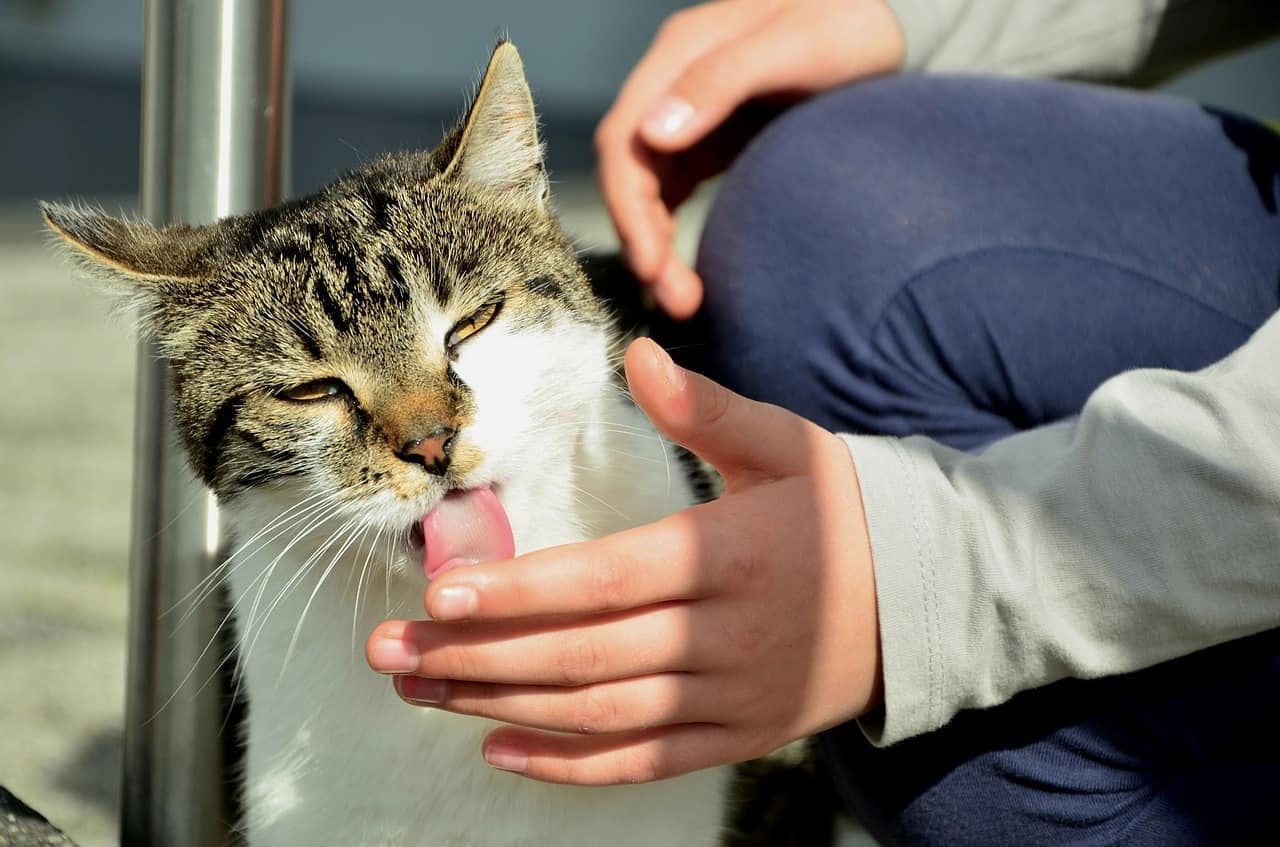
19. Nose Touching
This is a behavior that you will usually only observe performed between cats. It is interesting because not all cats will do it to their humans or other pets in the house, probably because it requires them to make themselves vulnerable by putting their delicate faces near potentially gnashing jaws.
It is just your kitty’s way of greeting, and they are equally likely to move in for a follow-up cuddle, or casually saunter away afterwards.
20. Biting
As you may well know or have experienced, there are degrees of biting. Gentle nibbling may be construed as playful and cute, but if you’ve ever been on the receiving end of an irate bite, you know how serious it can be. Cats can inflict severe damage with an angry bite, and this is an effective defense and predatory mechanism.
In the heat of play, as adrenaline surges, gentle nibbles can often escalate to more serious bites. It is at this stage that it is wise to walk away from the game if you want your hands and arms to remain intact!
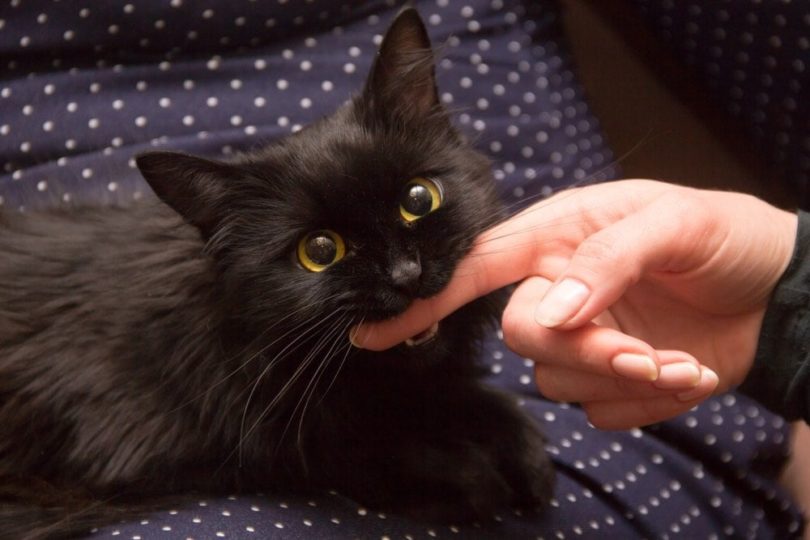
- Related read: Why Does My Cat Chew on My Fingers: 9 Possible Reasons
21. Chattering
It’s very amusing to watch a cat chattering when it has spotted a potential prey item, such as a bird or a mouse. Also known as chirping or twittering, their jaws spasm strangely and they emit an equally strange meow-chat sound, as they are transfixed in rapt attention. They seem to be particularly chattery when it comes to birds, possibly because they represent the greatest challenge as prey.
22. Changing Toilet Habits
If your feline friend suddenly changes their litter box habits and begins fouling outside of their box, this could be a sign that something is worrying them. They may have physical discomfort or pain resulting from a medical condition that warrants veterinary attention. Alternatively, it may be a sign of psychological distress resulting from not liking where the litter box is, the kind of litter being used, or having their toilet habits interfered with by another pet.
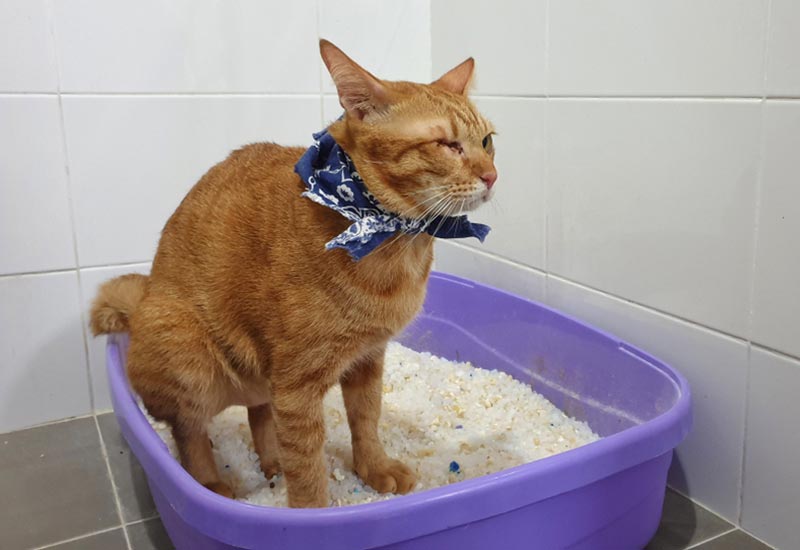
23. Tail
Your kitty’s tail can tell you much about its mood. If its tail is straight up with a delightful little curl on the end, this is normally a sign of a relaxed and happy cat. On the other hand, a tail that is stuck straight up with fur standing up and no kink at the end indicates fear. This may be followed by the cat making an urgent escape, or launching a full-blown angry attack.
A twitching tail signals agitation or annoyance. If that tail is swishing back and forth with gusto, you had better make a hasty retreat because the kitty is very angry indeed.
24. Fur
A cat will stand its fur on end in an attempt to look bigger, usually in response to a threat of some kind, or to look more impressive to another cat. This will usually be in combination with an arched back, and sometimes a raised tail, depending on the degree of agitation.
If a kitty’s fur is on end, and they are crouched down and subdued, this could be a sign that they are either cold or unwell. In these instances, it would do well to keep an eye on them for the development of any further symptoms that may necessitate veterinary attention.
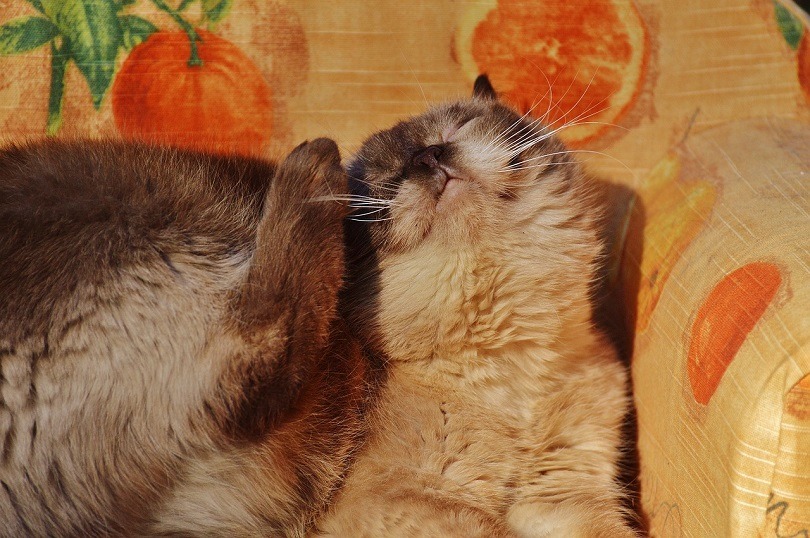
25. Pupils
It’s all in their eyes. A cat’s eyes can tell you much about what they’re thinking and planning. Very constricted pupils in the absence of bright sunlight can mean the kitty is starting to get annoyed. The next step, if the annoyance continues, will be an expansion of the pupils and a widening of the eyes, signaling that an attack is imminent.
If the kitty is chilled out and happy, it will often appear to have sleepy, half-closed eyes. And if it’s feeling particularly amorous, this may be accompanied by lazy blinks in your direction. Meanwhile, wide-open eyes signal alertness and activity.
 Conclusion
Conclusion
There are many other ways in which your cat communicates with you besides what we have listed—these points just cover the basics. Your own cat’s communication tactics are tailored by them specifically for your benefit, and we’re sure you could add to this list.
However, if you’re a new cat owner, and soon-to-be-worshipper, hopefully, this list has shed some light on some previously confusing behaviors.
See also:
Featured Image Credit: Stanimir G.Stoev, Shutterstock


 The 25 Ways Cats Communicate
The 25 Ways Cats Communicate



